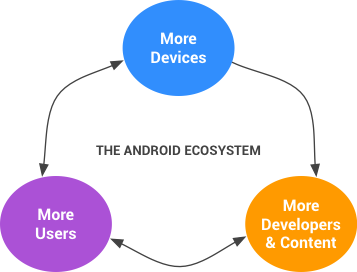「Android 互換デバイス」とは、サードパーティ デベロッパーが Android SDK および NDK を使用して開発したサードパーティ製アプリを実行できるデバイスです。Android 互換デバイスは、互換性定義ドキュメント(CDD)の要件に準拠し、互換性テストスイート(CTS)に合格している必要があります。Android 互換デバイスは Android エコシステムに参加でき、Android Play ストアおよび Google モバイル サービス(GMS)アプリスイートのライセンスを取得できる可能性があるほか、Android 商標の使用が許可されます。Android ソースコードは誰でも使用できますが、Android エコシステムに参加していると見なされるためには、デバイスが Android 互換である必要があります。
このドキュメントでは、Android 互換デバイスであることを確認するための手続き、要件、テストについて定めた「Android 互換性プログラム」の概要について説明します。
互換性のある Android デバイスをビルドする理由
カスタマイズ可能なデバイスが欲しいユーザー

図 1. デバイスの互換性を犠牲にしない Android エコシステム
常時ユーザーのそばにあり、ユーザーが常時使用しているモバイル デバイスは、インターネットへのゲートウェイです。機能を拡張してカスタマイズしたくないユーザーなどいません。そのため、Android はアフターマーケット アプリを実行させる堅牢なプラットフォームとして設計されました。
数で上回るデベロッパー
ユーザーが必要とすると思われるソフトウェアをすべて開発できるデバイス メーカーはありません。ユーザーが望むアプリを開発するにはサードパーティのデベロッパーが必要になるため、Android オープンソース プロジェクト(AOSP)は、アプリ開発をできるだけ簡単でオープンにすることを目指しています。
誰もが共通のエコシステムを必要としている
バグを回避するためにコード デベロッパーが作成したコード行はすべて、新しい機能の追加とは無関係です。モバイル デバイスの互換性が高いほど、該当するデバイスで実行する必要に迫られるアプリが増えます。完全互換の Android デバイスを構築することにより、Android 向けに作成された膨大なアプリから利益が得られる一方、より多数のアプリ構築に対するデベロッパーのインセンティブも高められます。
プログラムの目標
Android 互換性プログラムは、ユーザー、デベロッパー、デバイス メーカーなどの Android コミュニティ全体に利益をもたらせるよう機能します。
各グループは他のグループに依存しています。ユーザーは、幅広いデバイスと優れたアプリを求めています。優れたアプリを提供するのは、ユーザーが手にする多くのデバイスを対象にアプリを広めて大市場を目指すデベロッパーです。デバイス メーカーは、多種多様な優れたアプリを利用して、消費者にとっての製品価値を高めています。
こうした各グループに利益をもたらすことを目的として、下記の目標を定めました。
-
アプリ デベロッパーに一貫したアプリとハードウェア環境を提供する。確かな互換性標準がないと、デバイスは大幅に異なるため、デベロッパーはデバイスごとにアプリの異なるバージョンを設計する必要があります。互換性プログラムは、API や機能面で互換性のあるデバイスに要求されるものを正確に定義し、デベロッパーに提供します。デベロッパーはこの情報を使用して、設計上の判断を適切に下し、互換性のあるデバイスでアプリが適切に動作することを保証できます。
-
消費者に対する一貫したアプリ エクスペリエンスを実現する。ある 1 つの互換性のある Android デバイスで正常に動作するアプリは、同じ Android プラットフォーム バージョンと互換性のある他のデバイスでも正常に動作するはずです。Android デバイスはハードウェアとソフトウェアの機能が異なるため、互換性プログラムでは、Google Play などの配信システムが適切なフィルタリングを実装するために必要なツールも提供します。つまり、ユーザーには実際に実行できるアプリのみが表示されます。
-
デバイス メーカーが互換性を維持しながら差別化できるようにする。Android 互換性プログラムでは、サードパーティ アプリの実行に関連する Android の側面に重点を置いています。このため、デバイス メーカーは互換性のある独自のデバイスを柔軟に開発できます。
-
互換性に伴うコストとオーバーヘッドを最小限に抑える。互換性の確保は、デバイス メーカーにとって手軽で安価である必要があります。テストツールは無料のオープンソースであり、ダウンロードも可能です。 デバイス開発プロセス時にセルフテストを継続的に行えるよう設計されており、ワークフローの変更や、サードパーティへのデバイスの送付(テスト用途)などのコストを排除できます。必要な認定資格はなく、対応する費用や手数料もありません。
Android 互換デバイスを構築する
Android 互換のモバイル デバイスを構築する手順は次のとおりです。
- AOSP を使用して、デバイスに Android を実装します。
- デバイスが、Android 互換性定義ドキュメント(CDD)に準拠していることを確認します。CDD には、Android 互換デバイスに関するソフトウェア要件とハードウェア要件が列挙されています。
- 互換性テストスイート(CTS)に合格することを確認します。CTS は、開発プロセスで互換性を評価するために継続的に使用します。
互換性が確保できたら Android 互換デバイスと見なされ、Google モバイル サービス(GMS)のライセンス取得の検討と、Android 商標を使用するための準備に取りかかることができます。ブランドの取り扱いガイドラインについては、Partner Marketing Hub の Android セクションをご覧ください。
